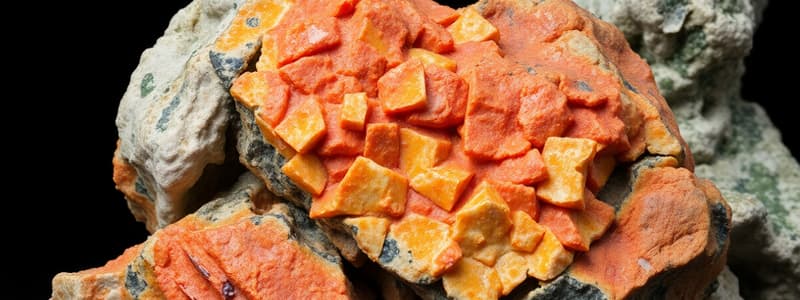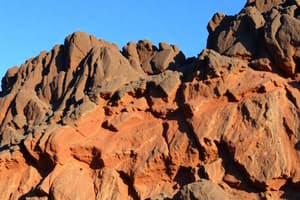Podcast
Questions and Answers
Which of the following statements best describes the relationship between the asthenosphere and the lithosphere?
Which of the following statements best describes the relationship between the asthenosphere and the lithosphere?
- The lithosphere is a partially molten layer upon which the solid asthenosphere slides.
- The lithosphere is a rigid layer that floats and moves on the more ductile asthenosphere. (correct)
- The asthenosphere and lithosphere are different names for the same layer of the Earth.
- The asthenosphere is composed of the same material as the lithosphere, but at a lower temperature.
At which type of plate boundary is subduction most likely to occur?
At which type of plate boundary is subduction most likely to occur?
- Divergent boundary
- All plate boundaries experience subduction equally
- Transform boundary
- Convergent boundary (correct)
How did the study of paleomagnetism contribute to the development of the theory of plate tectonics?
How did the study of paleomagnetism contribute to the development of the theory of plate tectonics?
- By demonstrating that the Earth's magnetic poles have remained constant over time.
- By revealing the mechanisms that drive plate movement.
- By providing evidence for seafloor spreading and continental drift through the identification of magnetic anomalies on the ocean floor. (correct)
- By providing evidence for the age of the Earth.
What is the primary difference between oceanic crust and continental crust?
What is the primary difference between oceanic crust and continental crust?
Which of the following scenarios best illustrates the process of assimilation affecting a magma's composition?
Which of the following scenarios best illustrates the process of assimilation affecting a magma's composition?
A geologist finds a coarse-grained igneous rock composed primarily of quartz, potassium feldspar, and muscovite. According to the classification of igneous rocks, what is the most likely name for this rock?
A geologist finds a coarse-grained igneous rock composed primarily of quartz, potassium feldspar, and muscovite. According to the classification of igneous rocks, what is the most likely name for this rock?
Which of the following processes is most directly associated with the formation of a continental rift?
Which of the following processes is most directly associated with the formation of a continental rift?
During regional metamorphism, what two main factors lead to the development of foliated textures in metamorphic rocks?
During regional metamorphism, what two main factors lead to the development of foliated textures in metamorphic rocks?
Which of the following statements accurately describes the relationship between the asthenosphere and the lithosphere?
Which of the following statements accurately describes the relationship between the asthenosphere and the lithosphere?
A sedimentary rock contains rounded fragments of various sizes, including pebbles, sand, and silt, all cemented together. In what depositional environment would this rock most likely have formed?
A sedimentary rock contains rounded fragments of various sizes, including pebbles, sand, and silt, all cemented together. In what depositional environment would this rock most likely have formed?
Flashcards
What defines a mineral?
What defines a mineral?
Naturally occurring, inorganic solid with a specific chemical composition and crystalline structure.
What is hardness?
What is hardness?
Resistance to scratching.
What is magma?
What is magma?
Molten rock beneath Earth's surface.
What is Bowen's Reaction Series?
What is Bowen's Reaction Series?
Signup and view all the flashcards
What is weathering?
What is weathering?
Signup and view all the flashcards
Oceanic Crust
Oceanic Crust
Signup and view all the flashcards
Continental Drift
Continental Drift
Signup and view all the flashcards
Seafloor Spreading
Seafloor Spreading
Signup and view all the flashcards
Convergent Boundary
Convergent Boundary
Signup and view all the flashcards
Paleomagnetism
Paleomagnetism
Signup and view all the flashcards
Study Notes
- Study notes for Geology exam
Minerals
- Minerals must meet specific criteria and have recognizable physical properties.
- Relative abundance of elements in Earth's crust relates to mineral formation.
- The physical properties are used to identify the minerals
Rocks
- Rocks are classified and identified via the rock cycle.
- Rock cycle is a continuous process of creation, destruction, and reformation.
- Igneous, sedimentary, and metamorphic rocks are all types of rock.
Igneous Rocks
- Igneous rocks form when magma or lava cools and solidifies and are classified as intrusive/plutonic or extrusive/volcanic.
- Intrusive rocks cool slowly within the Earth, while extrusive rocks cool quickly on the surface.
- Magma is the molten rock beneath Earth's surface
- Lava is molten rock at the surface.
- Magma forms through mechanisms that trigger melting at depth.
- Magmas differ in composition, affecting rock type.
- Partial melting and assimilation impacts magma's composition.
- Bowen's Reaction Series outlines mineral crystallization order.
- The texture and mineral composition determines the type and classification of igneous rocks.
Sedimentary Rocks
- Sedimentary rocks form through physical and chemical weathering processes.
- Clastic sedimentary rocks form from fragments of other rocks, and are classified by particle size.
- Chemical sedimentary rocks form from precipitation of minerals from solution.
- Sedimentary rocks are found in specific sedimentary environments of deposition.
Metamorphic Rocks
- Metamorphism is the process that causes rocks to change in texture and mineral composition.
- Metamorphic rocks form when existing rocks transform due to heat, pressure, or chemical changes.
- Metamorphic rocks are classified by texture and composition.
- Foliation is the layering or banding in metamorphic rocks and result from directional pressure.
- Metamorphic grade indicates the intensity of metamorphism.
- Metamorphism occurs in contact, regional and other various settings.
Plate Tectonics
- Earth is composed of a core, mantle, and crust, each with unique dimensions, properties, and composition.
- The lithosphere, asthenosphere, continental crust, and oceanic crust differ in dimensions, properties, and composition.
- Continental drift, seafloor spreading are key concepts.
- Convergent, divergent, and transform plate boundaries each have distinct characteristics.
- Paleomagnetism and polar wander curves support plate tectonics.
- Study of magnetism in rocks in relation to where they are located.
- Hot spots and rift systems provide evidence for plate movement.
Studying That Suits You
Use AI to generate personalized quizzes and flashcards to suit your learning preferences.




